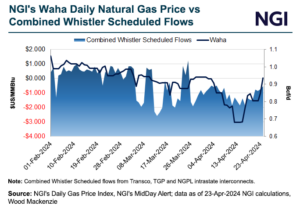LNG | LNG Insight | NGI All News Access | NGI The Weekly Gas Market Report
European Natural Gas Prices Top $100 as ‘Panic Buying’ Fuels Record Amid War in Ukraine – LNG Recap
Chaos reigned in the global commodity markets Monday as Russia’s attack on Ukraine intensified, sending European natural gas futures to record highs and Brent crude to levels not seen in 14 years.

Russian President Vladimir Putin said Saturday that the West’s sanctions – which for now have exempted energy exports – were “akin to a declaration of war.” The following day, U.S. Secretary of State Antony Blinken said the country and its allies were considering a Russian oil embargo. The weekend’s developments raised the specter of sanctions for other energy exports or the possibility of Europe losing natural gas imports from Russia, its largest supplier.
The European gas benchmark Title Transfer Facility shattered records Monday, when the prompt contract hit an intraday high of nearly $110/MMBtu. It settled at almost $73, breaking the previous record of $61.668 set Friday.
“The eye-watering risk premium suggests expectations that gas flows will potentially be disrupted by sanctions on Russian energy exports or damage to pipeline infrastructure, or simply a halt in flows from either side,” said Rystad Energy analyst Kaushal Ramesh.
Europe relies on Russia for about a third of its natural gas supplies, a portion of which move through Ukraine. Russia’s Deputy Prime Minister Alexander Novak reportedly said Monday that Russia has “every right” to stop gas flowing to Germany via Nord Stream 1 in response to the West’s sanctions. He added, however, that the country has not made that decision.
Prices have skyrocketed despite the fact that warmer weather is forecast for the continent during the second half of March, flows from Russia remain high and wind power generation is also expected to strengthen in the coming weeks. European prices are also so much higher than those in North Asia that the continent will continue to attract LNG cargoes.
“These levels cannot be explained by any known fundamental price,” analysts at Engie EnergyScan said in a note to clients Monday. “In a world of scarcity, they reflect the panic buying of physical players who have to cover their short-term needs but also of players who have to fill their storages.”
The European Commission is expected to unveil a plan this week for how to cut its reliance on Russian energy supplies, which is likely to include requirements that storage be refilled more aggressively ahead of winter.
Ramesh noted that prices are climbing so high that demand destruction is soon likely, which could help free up more gas for stocks. European inventories are at about 28% of capacity, compared to the five-year average of 38%.
European nations have already moved to cut their dependence on Russian natural gas. Germany’s economy ministry said Saturday that a state-owned bank has signed a memorandum of understanding with Nederlandse Gasunie NV and RWE AG to build an LNG import terminal in Brunsbuettel. The announcement partly made good on a plan to accelerate such development announced by Chancellor Olaf Scholz shortly after Russia invaded Ukraine.
LNG prices in Asia are also likely to remain volatile and have also hit records amid the spike in European pieces. If Russian LNG exports were sanctioned, Asia and Europe would be forced to compete more intensely for cargoes.
For now, high prices and warmer weather are expected to keep Asian buyers on the sidelines, but Ramesh said “the market is keenly” watching developments.
The war has weighed on global equity markets and sent prices of other commodities such as coal and metals higher. Wholesale power prices in Japan jumped to a six-week high on fuel supply fears and gas-fired power plants there have curbed output, while power markets in Europe are also surging as fuel costs rise.
Brent crude hit its highest level since 2014 on Monday, when the May contract flew to an intraday high of $139.18/bbl, which helped pressure other commodities higher. The value of Brent-linked LNG is also ticking upward and remains above $20/MMBtu, according to NGI calculations.
In the United States, which has been more insulated from chaos in the global gas market, Henry Hub tested the $5 barrier again Monday, at one point trading around $5.18 before moving lower on a weaker weather outlook.
Feed gas deliveries were also nominated back near capacity of 13.52 Bcf on Monday. The jump follows issues at Freeport LNG and fog that disrupted loading at Sabine Pass in recent weeks.
Venture Global LNG Inc. also said Monday that it inked a 20-year sales and purchase agreement (SPA) with an affiliate of Shell plc to supply 2 million metric tons/year of the super-chilled fuel from the Plaquemines LNG export project in Louisiana. Venture Global has not yet sanctioned the project, but early construction work started last year and it is expected to enter service in 2024. The SPA expands Shell’s deal to take another 2 mmty from Venture Global’s Calcasieu Pass terminal, which is being commissioned in Louisiana.
Cheniere Energy Inc. also said Monday it has entered a fixed-price agreement with Bechtel Energy Inc. for engineering, procurement and construction services on the company’s expansion of the Corpus Christi LNG terminal. The announcement came the same day as Chart Industries Inc. said it had received additional limited notice to proceed for some of the expansion’s equipment.
The Stage 3 expansion would add seven midscale liquefaction trains and 10 mmty of capacity at the terminal. The project is expected to be sanctioned this summer.
Editor’s Note: This segment is regularly available to subscribers of NGI’s LNG Insight. It covers weekly developments in the global natural gas markets and is being made available free due to escalating tensions between Russia and Ukraine. To request a trial to NGI’s LNG Insight click here.
© 2024 Natural Gas Intelligence. All rights reserved.
ISSN © 1532-1231 | ISSN © 2577-9877 | ISSN © 1532-1266 |


